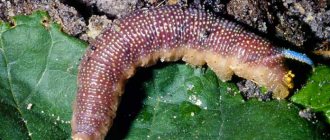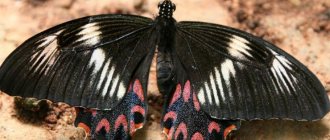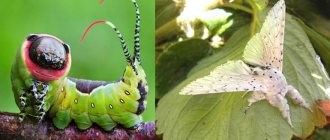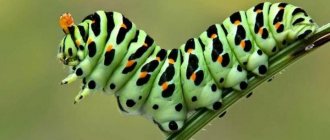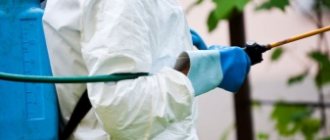Moths / Geometridae - up to 4 cm
One of the most common caterpillars in Russian latitudes, although not the largest, is one of the longest in the world.
The long body and underdeveloped false legs in the anterior part of the abdomen determined its peculiar movement. Because of this, moths are called land surveyors.
Moths are colored to match the color of the bark, which makes it difficult to notice, mistaking it for a small branch. In times of danger, having strong muscles, they stretch their body and freeze, remaining in this position for a long time.
11
Convolvulus hawkmoth
Description
The second largest hawk moth in Europe: 90–120 mm in wingspan. The front wings have blurred, broken bands, trimmed with a white outline on a general white background, the hind wings have three wavy black stripes. The fringe of the wings consists of alternating white and dark fields. The proboscis is very long - in the unfolded position it is twice the length of the body.
Habitats
It prefers open spaces and is “attached” to places where the food plant grows, but butterflies can migrate over long distances - hundreds of kilometers.
Lifestyle
It produces two generations within a year. After wintering, butterflies emerge from their pupae in early to mid-June, and second-generation adults emerge from late August to mid-September. Active at dusk. It lives wherever there are suitable flowers. The caterpillars' food plant is bindweed. Butterflies feed on pollen from garden plants, especially tobacco. The butterfly flies in May–November.
Reproduction
Caterpillar. Length – 100–130 mm, green or brownish.
Doll. In harsh snowless winters, the second generation pupae die, and the number is restored due to migrants from the Caucasus, Crimea, and Central Asia.
Limiting factors and status
The species is listed in the Red Book of the Saratov Region. Conservation status: 3 – rare species. Butterflies of the first generation are recorded as single finds, and in some years the number of butterflies of the second generation increases. The existence of the species is affected by weather conditions: severe frosts lead to freezing of the soil layer to a depth of 10–15 cm, which causes the death of the pupae.
Wine hawk moth / Deilephila elpenor - up to 5 cm
This large green caterpillar lives among grape leaves and can be found from mid-June to August, when it enters the pupal stage.
This caterpillar grows up to 50 mm, and the color can vary from light green to brown. In some regions of the planet you can also find black caterpillars of the wine hawk moth.
A caterpillar with a horn on its tail on the 4th and 5th rings of its body has 4 pairs of false eyes. It feeds on fireweed, fireweed, grape leaves and, less commonly, flowers of the balsam family.
9
Incredible species of caterpillars that exist side by side with humans
Today I would like to talk about an insect larva, which subsequently turns into a beautiful creature - a butterfly, at least this is written about in all the encyclopedias about wildlife and the world around us.
So, we will talk about caterpillars with horns and their features, which, judging by the name, should not be so few. Looking ahead, I would like to note that such caterpillars are characteristic of many species and they even pose a certain danger to smaller insects, and some to humans. But be that as it may, such representatives of the flora cause only delight in those who look at them, because they are incredibly beautiful and divinely beautiful.
Swallowtail / Papilio machaon - up to 5 cm
The distribution area of the large and beautiful caterpillar is quite extensive, and it can be found throughout North America, Eurasia and North Africa.
It goes through two stages in its development. The first stage lasts from May to June, and the second from August to September. It is in the second that the swallowtail reaches its maximum size, acquiring an unusual color with black stripes and orange spots on the body.
It loves to feed on flowers, and before pupation it starves, practically not eating.
8
Clothes moth
Clothes moth larvae
Clothes moth larvae cause great damage to people's personal belongings. The white caterpillar with a brown head feeds on wool, fur products, and cotton fabric. The female moth lays eggs in closets, pantries, and warehouses where outerwear made from natural materials is stored.
Clothes moth caterpillars are recognized as the smallest - the length of their translucent body varies from 1 to 12 mm. The more food they consume, the longer and thicker they become. The pest lives everywhere in Eurasia, North America, Australia, and some African countries.
Linden hawkmoth / Mimas tiliae - up to 6 cm
Just by the name you can understand that these caterpillars live on linden trees, but they also do not disdain to feed on the leaves of elms, birches, and alders. In addition, the linden hawk moth is a frequent visitor to fruit trees.
It grows up to 50–60 mm, and the body color is light greenish. There are red stripes along the sides along the entire length of the body, and yellow stripes on the bottom, on the abdomen. This stage of butterfly development lasts from late June to August.
Before pupation, the linden hawk moth caterpillar changes color, and the pupae overwinter not on a tree, but on the ground.
7
Ursa caja / Arctia caja - up to 6 cm
The caterpillar stage of this nocturnal beauty lasts from September to May, and in the final stage of development its body reaches a length of 60 mm.
This species is polyphagous and eats leaves of both fruit and wild trees, as well as inflorescences and leaves of berry bushes. The large, furry caterpillar is black in color and its entire body is covered with small hairs.
When in danger, the Kaya bear falls from tree branches to the ground and pretends to be dead, curling up into a ball. It is worth noting that the caterpillar itself is dangerous, as there is poison on the tips of the hairs that causes allergies, and if it gets into the eyes - conjunctivitis.
By the way, since we are talking about poison, you may be interested in an article about the most poisonous spiders in the world, which we recently published on our website TheBiggest.ru!
6
Myths, legends and interesting facts about the Death's Head butterfly
The unusual “appearance” of the insect served as a source of inspiration for Edgar Allan Poe, who, having become “acquainted” with “The Death’s Head,” wrote the story “The Sphinx,” in which the hero’s imagination turns a harmless insect next to him into some fantastically unsympathetic creature crawling along the slopes mountains
Hawk Moth "Adam's Head". Photo by: Milan Duniskvaric.
Cinema was not left out either. The legendary painting “The Silence of the Lambs” is complemented by a line about how a maniac uses the Acherontia atropos pupa - he places it in the victims’ mouths.
During daylight hours, the Death's Head Hawk Moth sleeps in a "dead sleep." Photo credit: Eduardo J Castro.
Several centuries ago, it was these insects that were blamed for the spread of epidemics and it was believed that scales that got into the eyes could cause the loss of vision.
In Russia, for a long time it was believed that if you see the “Dead Head”, you must kill it, so that none of your loved ones die.
No less original misconceptions existed in Europe. So, in Lincolnshire, the author of the book The Antiquary, residents of a certain village reported that the “Death’s Head” caterpillar would soon transform into... a mole. In addition, in England it was believed that the "Adam's Head" was used by soothsayers. Allegedly, they understood the squeak that these insects make, and from it they can understand the names of people who are destined to leave the world of the living in the near future.
Macro shot of the Death's Head hawkmoth butterfly - the insect's compound eyes and short thick antennae are clearly visible. Photo credit: f.scatton.
Due to the fact that the signs associated with this charming butterfly were not the most positive, real persecution began in many of its habitats, the result of which was that in many countries the “Death’s Head” became a rarity and was listed in the Red Book. But now we know that we shouldn’t be afraid of her! It’s much better to just admire!
Elena Samoilova, Kirill Usanov, Natureworld.ru
Blind Hawkmoth / Smerinthus caecus - up to 7 cm
The Blind Hawkmoth caterpillar has a greenish body color with a large spike at the end of the body.
Its spiracles are red, and along the entire surface of its body there are oblique white stripes. It can be confused with the caterpillar of the ocellated hawk moth, but the blind one has black spots on the end of the horn and the tips of the legs.
In adulthood, they reach a length of up to 70 mm, and their life cycle runs from July to the end of August. They feed mainly on willows, sometimes on poplars and birches.
5
Reproduction[ | code]
Egg | code
Oval, 1.5x1.2 mm in size, matte, pale green or bluish. Usually located on the underside of the leaves of forage plants.
Caterpillar | code
The caterpillars are quite large, with five pairs of legs.
First instar caterpillars reach a length of 12 mm and are covered with sparse individual small hairs. Caterpillars of the 4th instar already reach a length of 40-50 mm, with a weight of up to 4 g. The caterpillar of the 5th instar is large, smooth, by the end of its development reaches a length of 15 cm, with a weight of 18-22 g. Caterpillars of the hawkmoth are a death's head.
On the left is a typical yellow color form, on the right is also a typical, but less common green form. There are forms with different colors: yellow-blue, green and brown. The most common is lemon yellow with blue oblique stripes converging on the back at an acute angle; the body, starting from segments 4 to 11, is dotted with black and blue dots. The horn is curved in the shape of the letter "S", grainy and rough. There are also caterpillars with a green color and with green stripes, as well as gray-brown ones with a white pattern. The latter type of color is not considered normal, which is proven not only by the great rarity of such specimens in Europe, but also by the fact that at a young age, as well as after molting, they are temporarily green in color. The caterpillar stage lasts about 8 weeks.
Forage plants | code
Feeding caterpillars
The caterpillars feed primarily on plants of the nightshade family, mainly potatoes ( Solanum tuberosum
).
Other important forage plants from the same family are: common wolfberry, datura, belladonna, tobacco, Lycium europaeum
, as well as physalis, tomato, eggplant, bittersweet nightshade, black nightshade and other species of this genus.
Caterpillar
However, caterpillars are polyphagous and can also feed on many plant species from several families, including:
- Adoxaceae: elderberry, viburnum
- Umbrellas: carrots, dill
- Kutrovye: oleander
- Asteraceae: Canadian small petal
- Bignonioides: Catalpa bignonioides, Tecomaria capensis
- Brassicas: cabbage
- Hemp plants: hemp sativa
- Honeysuckle: honeysuckle, snowberry
- Euonymus: euonymus
- Amaranthaceae: beets
- Legumes: garden bean
- Hydrangeaceae: mock orange
- Lamiaceae: Vitex sacred
- Olive trees: ash, jasmine, lilac, privet, olive, phyllirea
- Malvaceae: hibiscus
- Norichinaceae: paulownia
- Plantains: Snapdragons
- Rosaceae: hawthorn, strawberry, apple, plum, pear, raspberry
- Rubiaceae: bedstraw
- Rutaaceae: rue, Citrus sinensis
- Norichinaceae: buddleia, mullein
- Nettles: nettle
In the Canary Islands the forage plants are: Cussonia
,
Spathodea campanulata
,
Cordia sebestena
, tabebuia, tobacco tree, clerodendrum.
, Solanum persicum
, common foliage and ash are also noted as forage plants
Doll
Doll | code
The pupa is smooth, shiny, 50-65 mm long in the male and 65-75 mm in the female, up to a maximum of 80 mm. Pupa weight of males is 7-10 g, females - 7-12 g. Immediately after pupation, the color of the pupa can be from yellow to cream, sometimes with a greenish tint on the back. After 12 hours, the pupa acquires its final red-brown color. Usually located in the soil at a depth of 15-40 cm, in a fragile earthen cocoon. The pupal stage lasts about a month.
Large harpy / Cerura vinula - up to 8 cm
Perhaps one of the most beautiful caterpillars in the world, having an unusual color.
She herself is green, and on her back there is a purple diamond-shaped spot. The brown head with a bright red border is retracted into the chest, which gives the caterpillar an unusual appearance. The thick caterpillar grows up to 6 cm, and at the end of the body there is a fork-shaped outgrowth.
When in danger, it swells up and assumes a threatening pose. In addition, in defense, it sprays a caustic liquid from the thoracic segment, which can cause slight irritation if it gets on human skin.
4
The most beautiful caterpillar in the world
Since we have already examined the most poisonous caterpillar in the world, we would now like to contrast it with the most beautiful and harmless one - the monarch larva. It is worth saying that even the name of this large caterpillar with a horn speaks for itself. A truly royal creature immediately appears, enchanting with its beauty and pleasing to the eye.
Its main color is white and, if not for the bright yellow stripes on its back, the caterpillar would look like a zebra, because it is also completely covered with black thin stripes. She has three pairs of horns: two on her head, two on her tail and the same number in the middle of her body. They are located symmetrically to each other.
The monarch butterfly is one of the most famous butterflies in North America. It is easily recognized by the characteristic pattern on its wings: black stripes located on a red background. The wingspan of the Danaid reaches 10.2 cm. This is one of the few insects that flies across the Atlantic Ocean during migration. In Russia, the species is found in the Far East.
Large peacock eye / Saturnia pyri - up to 10 cm
The caterpillars of this beautiful nocturnal butterfly develop from June to August, and have an unusual, and even frightening appearance.
A fairly large caterpillar, growing up to 100 mm, has a bright green body color, on which club-shaped hairs with thickenings at the tip are evenly distributed. Most often, such an unusual individual can be found on fruit trees, as well as on walnuts.
Before pupating, the green caterpillar with blue dots turns brownish in color. In reference books you can also find other names - pear peacock eye or saturnia.
3
Peacock eye atlas / Attacus atlas - up to 11.5 cm
The large caterpillar feeds alone on tree branches and bushes and is not considered a pest.
She has a green body with blue dots all over her body. Adults reach a length of 10 cm. They especially love the leaves of tropical trees, and in artificial conditions they readily eat lilac, poplar and oak leaves.
The caterpillar is of great importance in human economic life. In India, they produce silk, which is distinguished by its strength and wooliness. But in Thailand, cocoons are used as wallets.
2
Woodworm / Cossus cossus - up to 12 cm
Xylophagous caterpillars, that is, those that feed mainly on wood, live mainly on willows and poplars, but are also found on fruit trees.
This is a large pink caterpillar, and in the late period of development they have a brown-red color with a dark back and a black head. Reach sizes from 80 to 120 mm. They usually settle on old, already diseased trees, and overwinter in chambers specially gnawed out of tree trunks.
Woodworms are widespread in Russia, and in the Moscow region, a record specimen for these latitudes, 9 cm long, was discovered.
1
Butterfly bird
For an insect, hawk moths are simply enormous in size: 29-32 mm, some individuals reach thirty-six. The wingspan of representatives of the hawk moth family is also quite large - from 50 to 70 millimeters.
Hawkmoth butterflies have a unique appearance. Each species has its own color and pattern on the back and wings. Thus, the wine hawk moth has a burgundy tint (like wine), and the butterfly with the terrifying name death's head wears an image on its back that is strikingly reminiscent of pirate symbols - a skull.
Entomologists select the names of butterflies in accordance with their inherent traits or style of behavior. The hawk moth family received its “surname” because of its habit of eating, flying from flower to flower, just as drunkards (and previously they were only called hawk moths) move from table to table, from tavern to tavern, until they have drunk enough.
Not a very euphonious name, but it is firmly attached to insects.
King nut moth / Citheronia regalis - up to 14 cm
This butterfly has the largest caterpillar, and also has a very frightening appearance, because its entire body is covered with spikes, and on its head there is a pair of orange horns.
They grow from 12 cm to 14 cm in length. Despite its menacing appearance, the caterpillar is harmless. The hickory horned devil got its Latin name precisely because of its terrifying appearance.
It develops all summer, and by the end of August a beautiful butterfly hatches from the cocoon, which does not eat throughout its entire life. Although in our usual understanding, a butterfly with that name should eat everything.
Peacock eye io (Automeris io)
Family
Saturniidae.
Peacock-eyes Peacock-eyes io, distributed from Mexico to southern Canada.
Automeris io
Females lay eggs on different plants. Caterpillars, once they begin to eat the leaves of a plant of a certain type, do not move on to another plant. Having emerged from eggs, they live together in large numbers. After the third molt they lead a solitary lifestyle. They pupate in a cocoon of leaves of the host plant, and sometimes underground. The pupa overwinters. The wingspan of the butterfly is about 8 cm. At rest it is invisible, because folds the hind wings under the front ones. And when there is danger, it opens its wings, showing eyes on the hind wings. This repels insectivorous animals.
